BFS
 BFS copied to clipboard
BFS copied to clipboard
🇨🇭Search and Download Data from the Swiss Federal Statistical Office
BFS 
Search and download data from the Swiss Federal Statistical Office
The BFS package allows to search and download public data from the Swiss Federal Statistical Office (BFS stands for
Bundesamt für Statistik in German) APIs in a dynamic and reproducible
way.
Installation
install.packages("BFS")
You can also install the development version from Github.
devtools::install_github("lgnbhl/BFS")
Usage
library(BFS)
Get the data catalog
Retrieve the list of publicly available datasets from the data
catalog
in any language (“de”, “fr”, “it” or “en”) by calling
bfs_get_catalog_data().
catalog_data_en <- bfs_get_catalog_data(language = "en")
catalog_data_en
## # A tibble: 184 × 7
## title language publication_date number_asset url_bfs url_px
## <chr> <chr> <dttm> <dbl> <chr> <chr>
## 1 Acknowledgment of p… en 2023-06-22 08:30:00 25945442 https:… https…
## 2 Adoptions by differ… en 2023-06-22 08:30:00 25945406 https:… https…
## 3 Deaths by instituti… en 2023-06-22 08:30:00 25945423 https:… https…
## 4 Deaths by sex, citi… en 2023-06-22 08:30:00 25945436 https:… https…
## 5 Deaths since 1803 en 2023-06-22 08:30:00 25945437 https:… https…
## 6 Dissolved partnersh… en 2023-06-22 08:30:00 25945438 https:… https…
## 7 Divorces by canton,… en 2023-06-22 08:30:00 25945378 https:… https…
## 8 Divorces by duratio… en 2023-06-22 08:30:00 25945381 https:… https…
## 9 Divorces by institu… en 2023-06-22 08:30:00 25945387 https:… https…
## 10 Live births by inst… en 2023-06-22 08:30:00 25945410 https:… https…
## # ℹ 174 more rows
## # ℹ 1 more variable: catalog_date <dttm>
You can search in the data catalog using the following arguments:
-
language: The language of a BFS catalog, i.e. “de”, “fr”, “it” or “en”. -
title: to search in title, subtitle and supertitle. -
spatial_division: choose between “Switzerland”, “Cantons”, “Districts”, “Communes”, “Other spatial divisions” or “International”. -
prodima: by specific BFS themes using one or multiple prodima numbers. -
inquiry: by inquiry number. -
institution: by institution. -
publishing_year_start: by publishing year start. -
publishing_year_end: by publishing year end. -
order_nr: by BFS Number (FSO number).
For example, you can search data related to students:
bfs_get_catalog_data(language = "en", title = "students")
## # A tibble: 4 × 7
## title language publication_date number_asset url_bfs url_px
## <chr> <chr> <dttm> <dbl> <chr> <chr>
## 1 University of applie… en 2023-03-28 08:30:00 24367605 https:… https…
## 2 University of applie… en 2023-03-28 08:30:00 24367607 https:… https…
## 3 University students … en 2023-03-28 08:30:00 24367723 https:… https…
## 4 University students … en 2023-03-28 08:30:00 24367729 https:… https…
## # ℹ 1 more variable: catalog_date <dttm>
English (“en”) and Italian (“it”) data catalogs offer a limited list of datasets. For the full list please get the French (“fr”) or German (“de”) data catalogs.
Download data in any language
The function bfs_get_data() allows you to download any dataset from
the data
catalog
using its BFS number (FSO number).
You need first to find the asset number of the dataset.
library(dplyr) #install.packages("dplyr")
asset_number_students <- bfs_get_catalog_data(language = "en", title = "students") |>
dplyr::filter(title == "University students by year, ISCED field, sex and level of study") |>
dplyr::pull(number_asset)
asset_number_students
## [1] 24367729
You can then find the BFS number by calling bfs_get_asset_metadata().
This function returns a list containing the metadata of the asset. For
the student data, the BFS number is in the orderNR variable.
asset_meta_students <- bfs_get_asset_metadata(number_asset = asset_number_students)
bfs_number_students <- asset_meta_students$shop$orderNr
bfs_number_students
## [1] "px-x-1502040100_131"
You can also manually find the BFS number (FSO number) by opening the related URL official webpage.
url_bfs_students <- bfs_get_catalog_data(language = "en", title = "students") |>
dplyr::filter(title == "University students by year, ISCED field, sex and level of study") |>
dplyr::pull(url_bfs)
# open students dataset webpage
browseURL(url_bfs_students)
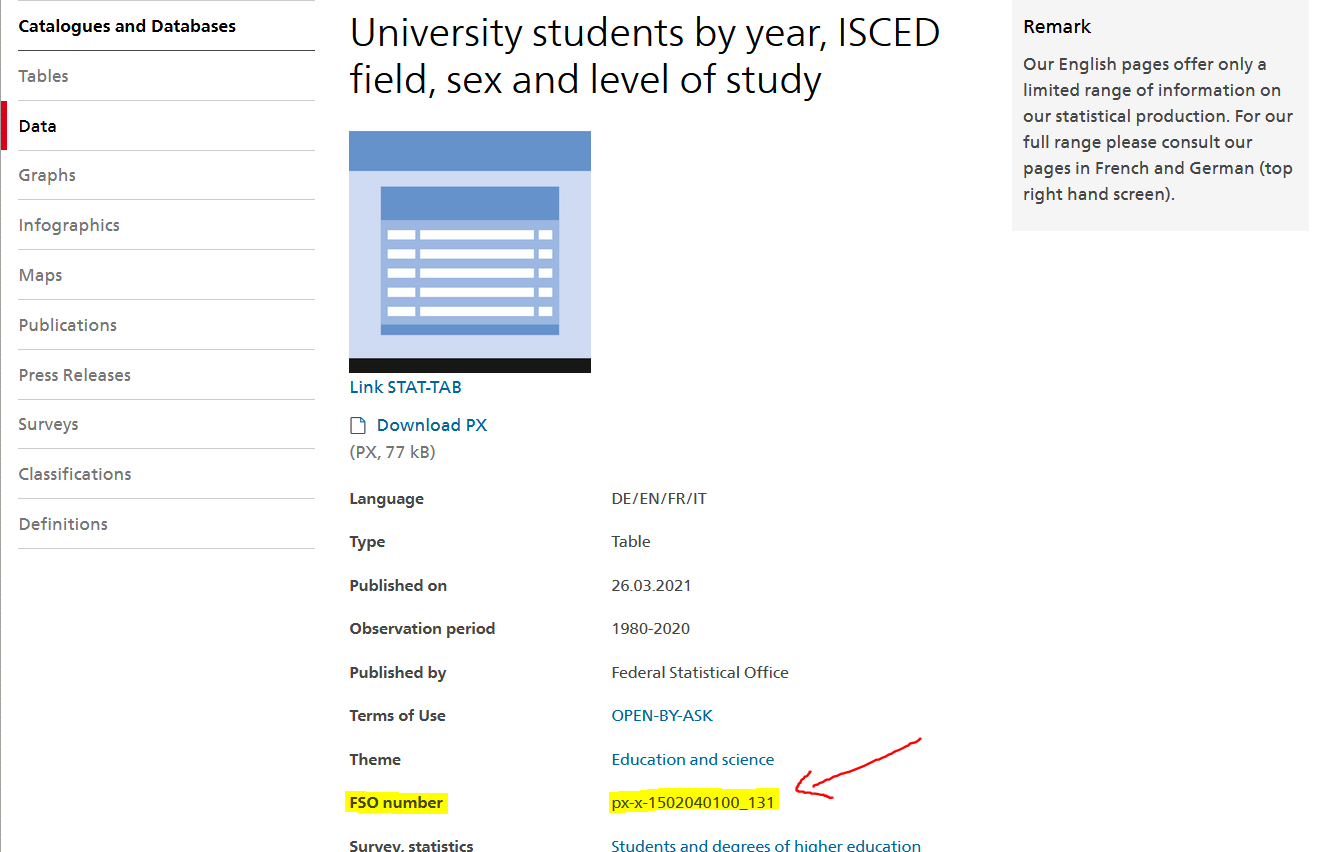
Finally you can get the data using the number_bfs argument in a given
language (“en”, “de”, “fr” or “it”) from the official PXWeb API of the
Swiss Federal Statistical Office.
bfs_get_data(number_bfs = bfs_number_students, language = "en")
## # A tibble: 18,060 × 5
## Year `ISCED Field` Sex `Level of study` `University students`
## <chr> <chr> <chr> <chr> <dbl>
## 1 1980/81 Education science Male First university degr… 545
## 2 1980/81 Education science Male Bachelor 0
## 3 1980/81 Education science Male Master 0
## 4 1980/81 Education science Male Doctorate 93
## 5 1980/81 Education science Male Further education, ad… 13
## 6 1980/81 Education science Female First university degr… 946
## 7 1980/81 Education science Female Bachelor 0
## 8 1980/81 Education science Female Master 0
## 9 1980/81 Education science Female Doctorate 70
## 10 1980/81 Education science Female Further education, ad… 52
## # ℹ 18,050 more rows
“Too Many Requests” error message
When running the bfs_get_data() function you may get the following
error message (issue #7).
Error in pxweb_advanced_get(url = url, query = query, verbose = verbose) :
Too Many Requests (RFC 6585) (HTTP 429).
This could happen because you ran too many times a bfs_get_*()
function (API config is
here). A solution is
to wait a few seconds before running the next bfs_get_*() function.
You can add a delay in your R code using the delay argument.
bfs_get_data(
number_bfs = "px-x-1502040100_131",
language = "en",
delay = 10
)
If the error message remains, it could be because you are querying a
very large BFS dataset. Two workarounds exist: a) download the BFS file
using bfs_download_asset() to read it locally or b) query only
specific elements of the data to reduce the API call (see next section).
Here an example using the bfs_download_asset() function:
BFS::bfs_download_asset(
number_bfs = "px-x-1502040100_131", #number_asset also possible
destfile = "px-x-1502040100_131.px"
)
library(pxR) # install.packages("pxR")
large_dataset <- pxR::read.px(filename = "px-x-1502040100_131.px") |>
as.data.frame()
Note that reading a PX file using pxR::read.px() gives access only to
the German version.
Query specific elements
First you want to get the metadata of your dataset, i.e. the variables
(code and text) and dimensions (values and valueTexts). For
example:
metadata <- bfs_get_metadata(number_bfs = "px-x-1502040100_131", language = "en")
# tidy metadata
library(dplyr)
library(tidyr) # for unnest_longer
metadata_tidy <- metadata |>
select(-valueTexts) |>
unnest_longer(values) |>
mutate(valueTexts = metadata |>
select(valueTexts) |>
unnest_longer(valueTexts) |>
pull(valueTexts)) |>
select(code, text, values, valueTexts, everything())
metadata_tidy
## # A tibble: 92 × 7
## code text values valueTexts time elimination
## <chr> <chr> <chr> <chr> <lgl> <lgl>
## 1 Jahr Year 0 1980/81 TRUE NA
## 2 Jahr Year 1 1981/82 TRUE NA
## 3 Jahr Year 2 1982/83 TRUE NA
## 4 Jahr Year 3 1983/84 TRUE NA
## 5 Jahr Year 4 1984/85 TRUE NA
## 6 Jahr Year 5 1985/86 TRUE NA
## 7 Jahr Year 6 1986/87 TRUE NA
## 8 Jahr Year 7 1987/88 TRUE NA
## 9 Jahr Year 8 1988/89 TRUE NA
## 10 Jahr Year 9 1989/90 TRUE NA
## # ℹ 82 more rows
## # ℹ 1 more variable: title <chr>
Then you can filter the dimensions you want to query using the text
and valueTexts variables and build the query dimension object with the
code and values variables.
# select dimensions
dim1 <- metadata_tidy |>
filter(text == "Year" & valueTexts %in% c("2020/21", "2021/22"))
dim2 <- metadata_tidy |>
filter(text == "Level of study" & valueTexts %in% c("Master", "Doctorate"))
dim3 <- metadata_tidy |>
filter(text == "ISCED Field" & valueTexts %in% c("Education science"))
dim4 <- metadata_tidy |>
filter(text == "Sex") # all valueTexts dimensions
# build dimensions list object
dimensions <- list(
dim1$values,
dim2$values,
dim3$values,
dim4$values
)
names(dimensions) <- c(
unique(dim1$code),
unique(dim2$code),
unique(dim3$code),
unique(dim4$code)
)
dimensions
## $Jahr
## [1] "40" "41"
##
## $Studienstufe
## [1] "2" "3"
##
## $`ISCED Fach`
## [1] "0"
##
## $Geschlecht
## [1] "0" "1"
Finally you can query BFS data with specific dimensions.
BFS::bfs_get_data(
number_bfs = "px-x-1502040100_131",
language = "en",
query = dimensions
)
## # A tibble: 8 × 5
## Year `ISCED Field` Sex `Level of study` `University students`
## <chr> <chr> <chr> <chr> <dbl>
## 1 2020/21 Education science Male Master 151
## 2 2020/21 Education science Male Doctorate 121
## 3 2020/21 Education science Female Master 555
## 4 2020/21 Education science Female Doctorate 306
## 5 2021/22 Education science Male Master 143
## 6 2021/22 Education science Male Doctorate 115
## 7 2021/22 Education science Female Master 599
## 8 2021/22 Education science Female Doctorate 318
Catalog of tables
A lot of datasets are not accessible through the official PXWeb API.
They are listed in the catalog of
tables.
You can search for specific tables using bfs_get_catalog_tables().
catalog_tables_en_students <- bfs_get_catalog_tables(language = "en", title = "students")
catalog_tables_en_students
## # A tibble: 5 × 7
## title language publication_date number_asset url_bfs url_table
## <chr> <chr> <dttm> <dbl> <chr> <chr>
## 1 Students at unive… en 2023-04-05 00:00:00 24865589 https:… https://…
## 2 Students at unive… en 2023-04-05 00:00:00 24865590 https:… https://…
## 3 Students at unive… en 2023-03-28 08:30:00 24345362 https:… https://…
## 4 Students at unive… en 2023-03-28 08:30:00 24345374 https:… https://…
## 5 Students at unive… en 2023-03-28 08:30:00 24345366 https:… https://…
## # ℹ 1 more variable: catalog_date <dttm>
Most of the BFS tables are Excel or CSV files. You can download an table
with bfs_download_asset() using the number asset.
library(dplyr)
tables_asset_number_students <- catalog_tables_en_students |>
dplyr::filter(title == "Students at universities and institutes of technology: Basistables") |>
dplyr::pull(number_asset)
file_path <- BFS::bfs_download_asset(
number_asset = tables_asset_number_students,
destfile = "su-e-15.02.04.01.xlsx"
)
Access geodata catalog
Display geo-information catalog of the Swiss Official STAC API using
bfs_get_catalog_geodata().
catalog_geodata <- bfs_get_catalog_geodata(include_metadata = TRUE)
catalog_geodata
## # A tibble: 281 × 12
## collection_id type href title description created updated crs license
## <chr> <chr> <chr> <chr> <chr> <chr> <chr> <chr> <chr>
## 1 ch.are.agglomera… API http… Citi… "The list … 2021-1… 2023-0… http… propri…
## 2 ch.are.alpenkonv… API http… Alpi… "The perim… 2021-1… 2022-0… http… propri…
## 3 ch.are.belastung… API http… Load… "Passenger… 2021-1… 2022-0… http… propri…
## 4 ch.are.belastung… API http… Load… "Passenger… 2021-1… 2022-0… http… propri…
## 5 ch.are.belastung… API http… Load… "Vehicles … 2021-1… 2022-0… http… propri…
## 6 ch.are.belastung… API http… Load… "Vehicles … 2021-1… 2022-0… http… propri…
## 7 ch.are.erreichba… API http… Acce… "Accessibi… 2021-1… 2022-0… http… propri…
## 8 ch.are.erreichba… API http… Acce… "Accessibi… 2021-1… 2022-0… http… propri…
## 9 ch.are.gemeindet… API http… Typo… "The typol… 2021-1… 2022-0… http… propri…
## 10 ch.are.gueteklas… API http… Publ… "The publi… 2021-1… 2023-0… http… propri…
## # ℹ 271 more rows
## # ℹ 3 more variables: provider_name <chr>, bbox <list>, inverval <list>
Download geodata
For example you can get information about the dataset “Generalised borders G1 and area with urban character”.
library(dplyr)
geodata_g1 <- catalog_geodata |>
filter(title == "Generalised borders G1 and area with urban character")
geodata_g1
## # A tibble: 1 × 12
## collection_id type href title description created updated crs license
## <chr> <chr> <chr> <chr> <chr> <chr> <chr> <chr> <chr>
## 1 ch.bfs.generalisi… API http… Gene… Administra… 2022-0… 2023-0… http… propri…
## # ℹ 3 more variables: provider_name <chr>, bbox <list>, inverval <list>
Download dataset by collection id with bfs_download_geodata() and
unzip file if needed.
# Access Generalised borders G1 and area with urban character
borders_g1_path <- bfs_download_geodata(
collection_id = "ch.bfs.generalisierte-grenzen_agglomerationen_g1",
output_dir = tempdir() # temporary directory
)
# you may need to unzip the file
unzip(borders_g1_path[4], exdir = "borders_G1")
By default, the files are downloaded in a temporary directory. You can
specify the folder where saving the files using the output_dir
argument.
Some layers are accessible using WMS (Web Map Service):
library(leaflet)
leaflet() %>%
setView(lng = 8, lat = 46.8, zoom = 8) %>%
addWMSTiles(
baseUrl = "https://wms.geo.admin.ch/?",
layers = "ch.bfs.generalisierte-grenzen_agglomerationen_g2",
options = WMSTileOptions(format = "image/png", transparent = TRUE),
attribution = "Generalised borders G1 © 2024 BFS")
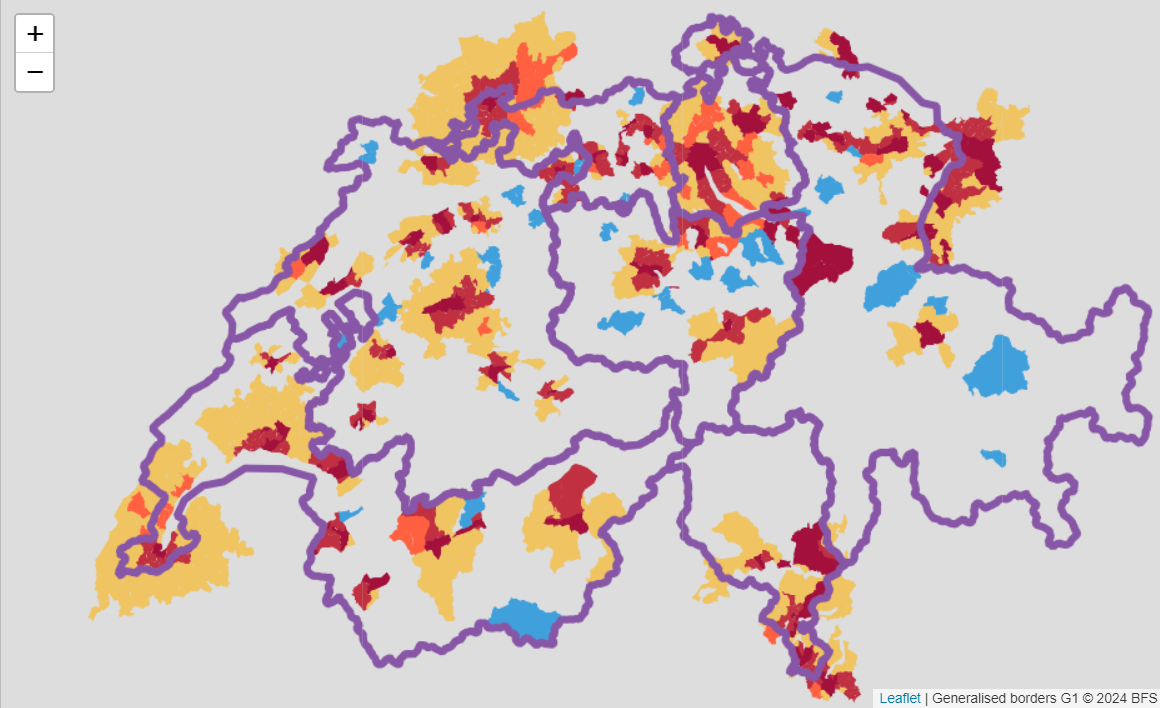
Cartographic base maps
You can get cartographic base
maps
from the ThemaKart project using bfs_get_base_maps(). The list of
available geometries in the official
documentation.
The default arguments of bfs_get_base_maps() can be change to access
specific files:
# default arguments
bfs_get_base_maps(
geom = NULL,
category = "gf", # "gf" for total area (i.e. "Gesamtflaeche")
type = "Poly",
date = NULL,
most_recent = TRUE, #get most recent file by default
format = "shp",
asset_number = "24025646" #change to get older ThemaKart data
)
A typical base maps ThemaKart file looks like this:

# list of geometry names: https://www.bfs.admin.ch/asset/en/24025645
switzerland_sf <- bfs_get_base_maps(geom = "suis")
communes_sf <- bfs_get_base_maps(geom = "polg", date = "20230101")
districts_sf <- bfs_get_base_maps(geom = "bezk")
cantons_sf <- bfs_get_base_maps(geom = "kant")
cantons_capitals_sf <- bfs_get_base_maps(geom = "stkt", type = "Pnts", category = "kk")
lakes_sf <- bfs_get_base_maps(geom = "seen", category = "11")
library(ggplot2)
ggplot() +
geom_sf(data = communes_sf, fill = "snow", color = "grey45") +
geom_sf(data = lakes_sf, fill = "lightblue2", color = "black") +
geom_sf(data = districts_sf, fill = "transparent", color = "grey65") +
geom_sf(data = cantons_sf, fill = "transparent", color = "black") +
geom_sf(data = cantons_capitals_sf, shape = 18, size = 3) +
theme_minimal() +
theme(axis.text = element_blank()) +
labs(caption = "Source: ThemaKart, © BFS")
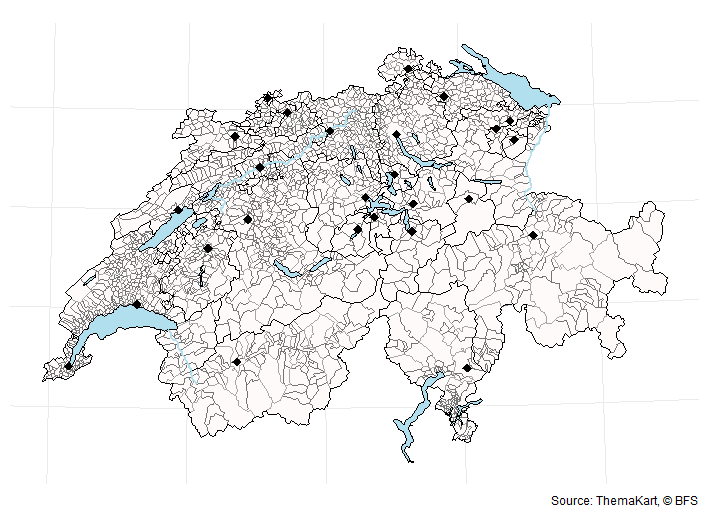
You can create an interactive map easily with the mapview R package.
library(mapview)
BFS::bfs_get_base_maps(geom = "bezk") |>
mapview(zcol = "name", legend = FALSE)
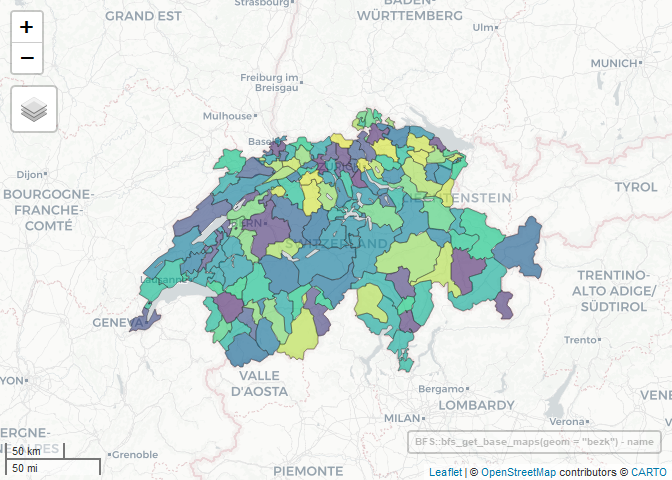
Swiss Official Commune Register
The package also contains the official Swiss official commune registers for different administrative levels:
-
register_gde -
register_gde_other -
register_bzn -
register_kt -
register_kt_seeanteile -
register_dic
# commune register data
BFS::register_gde
## # A tibble: 2,136 × 8
## GDEKT GDEBZNR GDENR GDENAME GDENAMK GDEBZNA GDEKTNA GDEMUTDAT
## <chr> <dbl> <dbl> <chr> <chr> <chr> <chr> <chr>
## 1 ZH 101 1 Aeugst am Albis Aeugst am A… Bezirk… Zürich 1976-11-…
## 2 ZH 101 2 Affoltern am Albis Affoltern a… Bezirk… Zürich 1848-09-…
## 3 ZH 101 3 Bonstetten Bonstetten Bezirk… Zürich 1848-09-…
## 4 ZH 101 4 Hausen am Albis Hausen am A… Bezirk… Zürich 1911-01-…
## 5 ZH 101 5 Hedingen Hedingen Bezirk… Zürich 1848-09-…
## 6 ZH 101 6 Kappel am Albis Kappel am A… Bezirk… Zürich 1911-01-…
## 7 ZH 101 7 Knonau Knonau Bezirk… Zürich 1848-09-…
## 8 ZH 101 8 Maschwanden Maschwanden Bezirk… Zürich 1848-09-…
## 9 ZH 101 9 Mettmenstetten Mettmenstet… Bezirk… Zürich 1848-09-…
## 10 ZH 101 10 Obfelden Obfelden Bezirk… Zürich 1848-09-…
## # ℹ 2,126 more rows
You can use registers to ease geodata analysis.
library(dplyr)
library(sf)
communes_sf <- bfs_get_base_maps(geom = "polg", date = "20230101")
communes_ge <- communes_sf |>
inner_join(BFS::register_gde |>
filter(GDEKTNA == "Genève"),
by = c("id" = "GDENR"))
bbox_ge <- sf::st_bbox(communes_ge)
lake_leman <- bfs_get_base_maps(geom = "seen", category = "11") |>
filter(name == "Lac Léman")
communes_ge |>
ggplot() +
geom_sf(data = lake_leman, fill = "lightblue2", color = "grey65") +
geom_sf(fill = "snow", color = "grey65") +
geom_sf_text(aes(label = name), size = 3, check_overlap = T) +
# bounding box
coord_sf(
xlim = c(bbox_ge$xmin, bbox_ge$xmax),
ylim = c(bbox_ge$ymin, bbox_ge$ymax)
) +
theme_minimal() +
theme(axis.text = element_blank()) +
labs(title = "Communes du canton de Genève",
x = NULL, y = NULL,
caption = "Source: ThemaKart, © BFS")
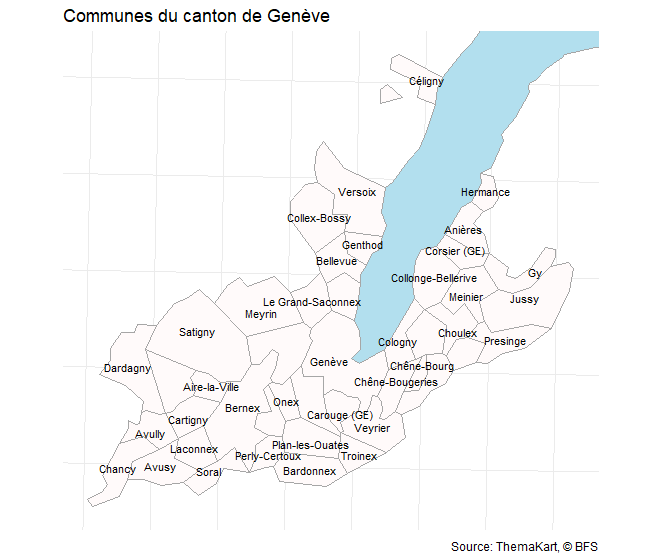
Main dependencies of the package
Under the hood, this package is using the pxweb package to query the Swiss Federal Statistical Office PXWEB API. PXWEB is an API structure developed by Statistics Sweden and other national statistical institutions (NSI) to disseminate public statistics in a structured way. To query the Geo Admin STAC API, this package is using the rstac package. STAC is a specification of files and web services used to describe geospatial information assets.
You can clean the column names of the datasets automatically using
janitor::clean_names() by adding the argument clean_names = TRUE in
the bfs_get_data() function.
Other information
This package is in no way officially related to or endorsed by the Swiss Federal Statistical Office (BFS).
Contribute
Any contribution is strongly appreciated. Feel free to report a bug, ask any question or make a pull request for any remaining issue.
